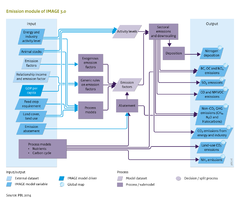Emissions/Description: Difference between revisions
Jump to navigation
Jump to search
Oostenrijr (talk | contribs) m (Text replace - "N2O" to "N<sub>2</sub>O") |
Oostenrijr (talk | contribs) m (Text replace - "NOx" to "NO<sub>x</sub>") |
||
| Line 59: | Line 59: | ||
===Land-use related emissions=== | ===Land-use related emissions=== | ||
CO<sub>2</sub> exchanges between terrestrial ecosystems and the atmosphere computed by the LPJ model are described in [[Carbon cycle and natural vegetation]]. The land-use emissions model focuses on emissions of other compounds, including greenhouse gases (CH<sub>4</sub>, N<sub>2</sub>O), ozone precursors ( | CO<sub>2</sub> exchanges between terrestrial ecosystems and the atmosphere computed by the LPJ model are described in [[Carbon cycle and natural vegetation]]. The land-use emissions model focuses on emissions of other compounds, including greenhouse gases (CH<sub>4</sub>, N<sub>2</sub>O), ozone precursors (NO<sub>x</sub>, CO, NMVOC), acidifying compounds (SO<sub>2</sub>, NH3) and aerosols (SO<sub>2</sub>, NO3, BC, OC). | ||
For many sources, the emission factor ([[#General approaches|Equation 1]]) is used ([[Emission table]]). Most emission factors for anthropogenic sources are from the [[EDGAR database]], with time-dependent values for historical years. In the scenario period, most emission factors are constant, except for explicit climate abatement policies (see below). | For many sources, the emission factor ([[#General approaches|Equation 1]]) is used ([[Emission table]]). Most emission factors for anthropogenic sources are from the [[EDGAR database]], with time-dependent values for historical years. In the scenario period, most emission factors are constant, except for explicit climate abatement policies (see below). | ||
Revision as of 10:38, 1 July 2014
Parts of Emissions/Description
| Component is implemented in: |
Components:and
|
| Projects/Applications |
| Models/Databases |
| Key publications |
| References |
|
